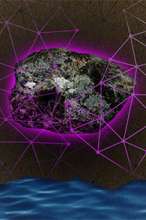Encouraging minerals to capture troubling radionuclides

Associated with contamination in certain spots around the world, pentavalent neptunium does not always behave the same as its stand-in when moving through the soil, according to scientists at University of Notre Dame and Pacific Northwest National Laboratory. The less studied pentavalent neptunium and the well studied hexavalent uranium are incorporated at dramatically different levels in calcite and other carbonate minerals. Assimilation in minerals can limit the radionuclides migration.
The radioactive metallic element neptunium is created when uranium-based nuclear fuel is burned up in electricity-producing commercial reactors and in plutonium-producing reactors operated for military purposes. Long-lived, toxic, and highly mobile in water, pentavalent neptunium can come in contact with human beings through a variety of routes. A recent example is the interaction of water with damaged nuclear fuel in Fukushima, Japan, in 2011. Understanding the range of processes that will hinder the transport of pentavalent neptunium, including incorporation into minerals that form naturally in the subsurface, can assist in disaster preparedness and environmental remediation.
Because neptunium does not occur naturally in any appreciable quantity and there is no natural analogue for its environmental chemistry, predictions for environmental transport of pentavalent neptunium are based on studies of hexavalent uranium. In part, this substitution is done because it is easier and cheaper to conduct studies with uranium. However, there are major differences in crystal chemistry of uranium and neptunium, suggesting they would not be incorporated in mineral structures the same way.
Using spectroscopic and imaging instruments at RadEMSL, the radiochemistry facility that is part of the U.S. Department of Energy's (DOE's) EMSL, scientists examined factors that influence structural incorporation of the two ions into carbonate and sulfate minerals.
Overall, growing carbonate minerals incorporated both ions at far higher levels than sulfate minerals. The experimental data also showed significant differences between how neptunium and its stand-in are incorporated into carbonate minerals. For example, the mineral calcite strongly prefers pentavalent neptunium to hexavalent uranium. However, not all minerals treated the radionuclides differently. Gypsum did not incorporate either.
More information: "Incorporation of Np(V) and U(VI) in Carbonate and Sulfate Minerals Crystallized from Aqueous Solution." Geochimica et Cosmochimica Acta 151:133-149. DOI: 10.1016/j.gca.2014.10.027
Journal information: Geochimica et Cosmochimica Acta
Provided by Pacific Northwest National Laboratory




















